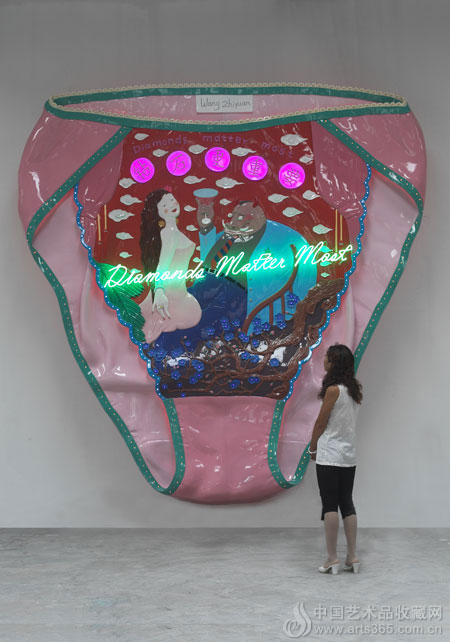
王志远 《物欲》 2008年 综合媒介 355x363x70cm
鸣谢:艺术家本人和798艺术场地
Wang Zhiyuan The Object of Desire 2008 Mixed media 355x363x70cm
Courtesy of the artist and ArtPlace798
王志远
1958年生于天津;现生活、工作在北京
Wang Zhiyuan
1958, Tianjing; now lives and works in Beijing
艺术家王志远的自述:
我选择“内裤”作为形式, 因为它一直被藏在某处而被忽略掉的,当我把它制成作品并挂在墙上便产生了幽默。“内裤”形式本身如同一个容器,有了这个容器我便可以往里装我想要的东西,内裤上表达的任何内容都从幽默开始,观众看作品也首先从幽默开始,或也可以说从“不正经”开始。我的经历告诉我真正“正经”的最终结局可能特别的不正经,“不正经”的所得到的可能特别的正经。
作品 “物欲”所表述的是我对于中国当下的感受。 刚刚打破平均主义的中国使一部分人先富了起来, 但缺少宗教和信仰的富有是可怕的。 尤其是我们这些50年代出生并生长在红旗下的人,面对当今社会金钱可以买到一切的情景, 内心不免产生眼前的这一切是新的开始还只是一种轮回?作品中我选择了二十世纪30-40年代上海流行歌手周旋的歌曲,她的即缓慢又糜烂的嗓音也正与我的作品相符。
作品 “内裤-- 多彩心”所想表达的很简单, 内裤加上可以变化色彩灯箱的“心”。 可以产生即热闹又空荡荡的感受。
如上我所表达的都发生在内裤上,因此希望观众们也都别当回事儿。
Artist statement by Wang Zhiyuan
I selected the form of “Underpants”, since the object has been for long hidden somewhere and was ignored. When I made the object into a piece of work and hang it onto the wall, the work evokes a sense of humour. The form of “Underpants” itself is like a container. With a container as such, I am able to put anything I think appropriate. All the images depicted on the underpants begin with humour. The viewers also start to view the work with humour, or it could be said that they start to view the work from “non-respect”. My experience has told me that the final outcome of true “respect” might be non-respectable to a larger extent. What has come out from “non-respect” might be respectable to a larger degree.
The work titled The Object of Desire has expressed my feelings towards China today. Just out of egalitarianism, China has made some of her people become richer, but it is terrible to see that many Chinese living today have got no belief or religion, however, richer. Facing the societal scene that money is able to buy everything, those like us born in the 1950s of last century and grew up under the red flag, have to think wholeheartedly that all the happenings in front of our eyes are a new start or metempsychosis? As part of the work, I have chosen the 1930s-40s’ songs sung by a then pop singer, Zhou Xuan from Shanghai. Her voice both sounding slower and erotic is just up to the taste of my work.
The work titled Underpants— color heart intends to express something very simple, an underpant plus a “heart” being changed in a light colour box. Thus, the work might evoke a feeling of something busy and void through reading.
As my afore-mentioned, everything takes place in underpants, so I hope that viewers do not matter much on them.
Translated by Jin Hua
策展人黄笃的陈述:
王志远:公共空间的“物恋”
王志远的作品“物欲”和“内裤—多彩心”以工业化的方式把女性内裤放大成艺术品,艺术品又变为象征物:它直接涉及到人对性的快感与对“艾滋病”恐惧,具有双刃剑的警示作用。这里,在更多意义上,道德戒律不是由人自身制定,而是由外部世界给予的自我欲望的约束。另一方面,内裤的公共空间化是传统道德规范的蔑视。性的开放既是解放个性,又是它自身的敌人。他的各种内裤上绘制了丰富多样的故事,混杂了各种与性、爱情、通俗文化有关的野史文化,而这种野史美学更多来自民间版画形式和杨柳青色彩语言,但在材料处理上又机智地使用了工业化的绚丽多彩。
当这种私密的“内裤”被转换成公共空间中一种“物恋”视觉时,它在当代社会中就产生了某种诙谐感,既是被窥视的性的对象,又人的欲望的“圣物”。它剖析了人的矛盾心理——既想偷窥和获得,又充满恐惧。这是一个难以解答的问题。
Curatorial statement by Huang Du
Wang Zhiyuan: “Object love” in a public space
Wang Zhiyuan’s work titled The Object of Desire and Underpants — Color Heart were created in a way of mass production, depicting female’s underpants as the subject matter and turned them into a piece of art, the piece of art thus became a signifier: it directly relates people with the sexual joy versus fear of “Aids”, playing a warning role like a sword of both sides. On one hand, a hidden meaning here refers to the moral taboos, which were set not by human beings themselves, rather, they were the constraints of self desire offered by the outside world; on the other, underpants put in a public space is contempt against traditional moral norms. Liberation of sex itself liberates one’s personality, in the meanwhile, is an enemy to the self. His underpants in a great variety were made to tell rich and various stories, hybridizing all kinds of unofficial cultures relating to sex, love and popular culture. However, this kind of unofficial aesthetics originated more out of folk prints such as the folk prints in colour from Yang Liuqing. But in terms of their techniques and materials, the artist is so intelligent in using the rich color popular in the mass production industry.
When this privacy, the “underpants” was transferred into an “object love” visualized in a public space, it evokes a sense of humour in a contemporary society. Thus the “underpants” is both an object of sex to be peeped through, and a “spiritual object” of human’s desire. It analyzed people’s ambivalence: a desire to peep and gain, but full of fear. This issue is hard to give an answer.
Translated by Jin Hua













